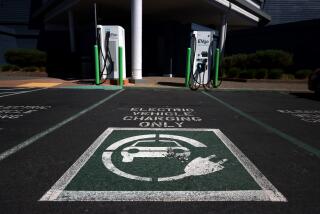Vehicle mileage estimates get real
- Share via
That 55-mile-per-gallon hybrid car you’ve been eyeing may end up being a 44-mpg hybrid if you wait for the 2008 model.
The federal Environmental Protection Agency announced a new system Monday for evaluating fuel economy that will lower mileage estimates for most vehicles.
For the record:
12:00 a.m. Dec. 14, 2006 For The Record
Los Angeles Times Thursday December 14, 2006 Home Edition Main News Part A Page 2 National Desk 2 inches; 90 words Type of Material: Correction
Mileage tests: A front-page article Tuesday about changes in the way the Environmental Protection Agency estimates mileage for cars and trucks cited an out-of-production vehicle, the Ford Excursion, as an example of the kind of medium-duty trucks that must begin displaying EPA mileage labels in the 2011 model year. Medium-duty trucks with loaded weight ratings of 8,500 to 10,000 pounds that currently are being sold include the Hummer H2 from General Motors and many larger pickups such as the Ford F-250 Crew Cab and the Dodge Ram 3500 Crew Cab.
On average, vehicles rated under the 2008 method will post a 12% drop in city gasoline mileage and an 8% decline in highway mileage, said Bill Wehrum, the EPA’s acting assistant administrator for air and radiation.
With the new testing requirements, the EPA is attempting to come up with estimates that more closely reflect the real-world mileage motorists can expect when they purchase a vehicle.
Under the current system, which has been in effect since 1975 and was last changed in 1984, actual mileage is often far lower than the posted EPA ratings.
Hybrids will be hit harder because the new test eliminates some of the all-electric driving that helped them produce impressive results under the present system, Wehrum said.
For the first time, the EPA also will require estimated mileage to be posted on medium-duty pickup trucks, vans and sport utility vehicles -- behemoths such as the Ford Excursion that weigh between 8,500 and 10,000 pounds.
Such vehicles have been exempted from the ratings because they were considered commercial trucks. But as growing numbers of Americans adopt large SUVs and pickups as family vehicles, environmentalists and others have called on regulators to require mileage information for them as well.
Automakers won’t have to publicize the big trucks’ mileage estimates until the 2011 model year, however. The EPA did not explain the three-year delay but typically gives manufacturers substantial lead time when applying new regulations.
A recent study by automotive information website Edmunds.com found that the average mileage for passenger cars and light trucks was about 14% less than EPA estimates.
In part that’s because the agency’s current test doesn’t include much stop-and-go traffic or lead-footed acceleration. Air conditioners -- notorious for lowering mileage by sucking up engine power -- aren’t turned on, and all testing is done under conditions that simulate a 70-degree environment.
The new system will use more high-speed driving, partly in 20-degree cold. Air conditioning will be on some portion of each driving cycle, and there will be more stop-and-go and rapid-acceleration driving.
The mileage for gas-electric hybrids probably will be 20% to 30% lower than present estimates for city driving and 10% to 20% lower on the highway. These vehicles quickly lose their all-electric advantage when operated in cold weather or quickly accelerated, Wehrum said.
“This is all about providing more and better information to consumers,” he said.
Toyota Motor Corp., which makes the popular Prius hybrid, now rated at 60 miles per gallon in the city and 51 on the highway -- a combined rating of 55 mpg -- supports the changes.
“This doesn’t change the car or the technology, just the way the mileage is calculated,” said Ming-Jou Chen, spokeswoman for Torrance-based Toyota Motor Sales USA. “It makes the estimate closer to real-world numbers, and we fully support that.”
Moe Durand, a spokesman for Mitsubishi Motors Corp., which is bringing one of the first 2008 models to market in the U.S., said he was “quite pleased” with the averages cited Monday by EPA officials.
Environmental groups applauded, too.
The EPA “did an excellent job” with the revisions, said Russell Long, executive director of the Bluewater Network, the San Francisco-based environmental group that sought the changes. The new procedures can help motorists save money and reduce pollution by providing more accurate mileage information for them to use in their car-buying decisions, Long said.
“We’re thrilled with it,” he said.
The new system seems to be one that even auto dealers -- notoriously sensitive to anything that could hurt a sale -- can get behind.
“It won’t have a big impact,” said Fritz Hitchcock, whose Hitchcock Automotive Resources of Puente Hills owns several Toyota franchises and a BMW dealership.
“There’s such intense comparison shopping on the Internet that people will know all about the changes” before ever setting foot in a dealership, he said. “And in the end, people find a reason to buy what they want to buy” regardless of mileage estimates.
Automakers are working on a plan for 2008 models that come out in 2007 that will enable shoppers to see the new fuel economy estimates and the mileage ratings that would have been attached to the vehicle under the present system.
As part of the new approach, the EPA redesigned its fuel economy window sticker.
It will provide a range of mileage for competing vehicles; estimated city and highway mileage for the vehicle displaying the sticker; the vehicle’s estimated fuel costs for a year, based on 15,000 miles of driving; and a caution that gas mileage will vary based on driving conditions and driving styles.
The new EPA mileage estimates won’t harm automakers’ ability to meet federal rules requiring an industrywide average fuel economy of 27.5 miles per gallon for cars and 21 mpg for sport utility vehicles, pickup trucks and vans.
Those requirements are part of the corporate average fuel economy program run by the Transportation Department.






